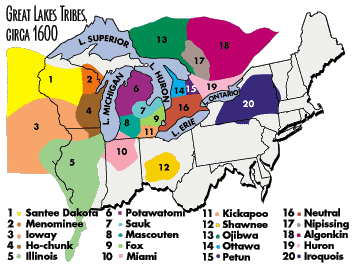As the demographic composition of Grand Rapids continues to change, it’s easy to imagine the current influx of immigrants from other countries and elsewhere in the United States and Michigan is something new and uniquely challenging for Grand Rapidians. In reality, the area’s history is full of these kinds of changes.
The earliest identified settlers of the area were the Hopewell Indians, known primarily for the complex engineering of their large burial mounds. Grand Rapids has one of the best preserved of these earthworks downtown, although what remains is only a small part of what the Hopewell built. It’s uncertain what happened to the Hopewell peoples. Some historians speculate that their collapse was due to a greater use of the bow and arrow on the North American continent Since they left no written records, we can only interpret their culture through the ceremonial items they left in their burial mounds, the most common of which are chipped points and blades, celts and adzes, as well as some ceramics and ceremonial ornaments and jewelry made of shells, silver, copper, and mica. Many of the products they crafted were made of materials found far from West Michigan, so clearly there were cross-continental trade routes in existence at the time.
The sixth century saw the decline of the Hopewell, and during the Late Woodland period, a number of other smaller cultures appear and disappear in the fossil record, and by the 16th century, when the French began exploring the area, they found a number of different tribes living along the shores of Lake Michigan, including the Ottawa, the Chippewa, the Menominee, the Sauk, the Fox, the Mascouten, the Miami, and the Potawatomi peoples. They lived separately, spoke different languages (some of them dialects of Algonquin), and had their own cultural as well as food growing or gathering practices which were dependent in large part on the local climate. The Potawatomi and the Ottawa periodically encamped together.
During this period trade flourished among the many groups. The Ottawa (Algonquin for "to buy or sell") were particularly involved in this inter-tribal trade. By the mid-17th century, the Iroquois Indians began expanding their territory into the Great Lakes region in an attempt to monopolize the lucrative fur trade the Europeans had introduced. The Iroquois were fierce fighters, armed with rifles, and their efforts resulted in either the death, forced integration, or the out migration of tribes who fled the violence resulting from the Beaver Wars.
Later the French resumed the fur trade, but conflicts with the Iroquois and the British, as well as an oversupply of furs, made it less lucrative over time. Eventually they abandoned their trading forts in the upper Great Lakes. In 1701 they allowed Antoine Laumet de Lamothe Cadillac to build a model trading post at what today is Detroit, and the French began encouraging the many tribes they had been trading with to do business with them in southeast Michigan instead. Combining these tribes together in one area had some less than peaceful results for the French. Eventually the British moved in on French territory and there were multiple players rivaling each other for dominance of the fur trade. The British treated the native tribes differently, however, and relations between the British and the various Indian tribes was never as friendly or cooperative, even during more peaceful periods.
Eventually the tribes we associate with Michigan history settled the previously emptied out areas. These were the people of the Three Fires, the Ottawa, the Chippewa, and the Potawatomi, who called themselves the Anishinabek, or “the Original People.” The numerous wars with the Iroquois, the French, the British, as well as inter-tribal conflicts had eliminated many tribes from Michigan, so while Europeans visiting in 1600 and 1800 would have seen territory controlled by Indians, there had been a significant amount of shake up as to who controlled what and when. Then, as it has been since, West Michigan's population was in flux.


No comments:
Post a Comment